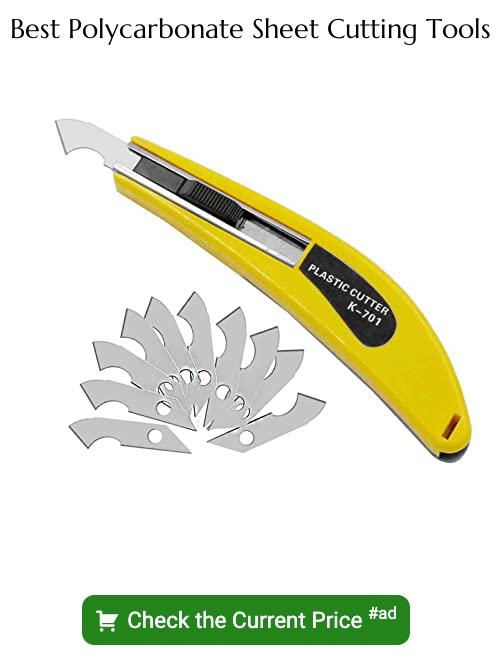Last updated on
Learn the proper steps to accurately and safely cut polycarbonate sheets for your next project.
Key takeaways:
- Use the right tools: Fine-toothed saw, utility knife, straight edge, gloves, measuring tape, and sandpaper/deburring tool.
- Measure and mark accurately before cutting.
- Score thin sheets and snap them along the groove.
- Use a circular saw or jigsaw for thicker sheets or curved cuts.
- Sand the edges and clean up after cutting.
Tools Required to Cut Polycarbonate Sheeting

To ensure a successful cut, having the right tools is paramount. Here’s what you’ll need:
- Fine-toothed saw: A circular saw for straight cuts or a jigsaw for curved ones will work, provided they’re equipped with a blade designed for plastics.
- Utility knife: Ideal for scoring the sheet, making a shallow cut that facilitates a clean break.
- Straight edge or ruler: Use this as a guide to score or saw in a perfectly straight line.
- Protective gear: Safety goggles and gloves are a must to safeguard against flying debris and sharp edges.
- Measuring tape: Precision is crucial, so accurate measurements are necessary before cutting.
- Sandpaper or a deburring tool: These tools are used for smoothing the edges post-cutting to ensure a refined finish.
Selecting the appropriate tool depends on the thickness of the polycarbonate and the type of cut required. Lighter sheets can be scored and snapped, while thicker panels require sawing.
How to Cut Polycarbonate Sheets – Steps
Before beginning, ensure the polycarbonate sheet is secured on a flat surface with the protective film in place to prevent scratches.
1. Measure and Mark: Accurately measure the area to be cut; use a straight edge and a fine-point marker to draw your cut line.
2. Scoring: For thin sheets, repeatedly run a utility knife along the cut line to create a deep groove. Use firm, steady pressure to score a straight line.
3. Snapping: Gently bend the polycarbonate sheet along the scored line. The sheet should snap cleanly along the groove.
4. Using a Circular Saw: For thicker sheets, fit a circular saw with a fine-toothed blade. Saw along the cut line at a steady pace, ensuring the blade does not overheat.
5. Using a Jigsaw: For curved cuts, a jigsaw with a fine-toothed blade is appropriate. Move slowly following the marked line for accuracy.
6. Sanding the Edges: After cutting, sand any rough edges with fine-grit sandpaper to achieve a smooth finish.
7. Cleaning Up: Remove the protective film, and clear away any burrs or dust from the cut edge.
Note: Blade selection is critical; for optimal results, use blades designed for cutting polycarbonate or plastic.
Safety Precautions When Cutting Polycarbonate
Before commencing work with polycarbonate sheets, ensure you are wearing appropriate safety gear. Protective eyewear guards against flying fragments that can result from cutting, while gloves protect hands from sharp edges. Additionally, operate in a well-ventilated space to avoid inhaling plastic dust.
Make certain that the polycarbonate sheet is securely fastened to a stable surface. This not only prevents slippage, which could lead to imprecise cuts or injury but also minimizes vibrations that can cause cracking or chipping of the material.
Employing tools with sharp blades is critical – dull blades can cause uneven cutting and might require excessive force, heightening the risk of an accident. After each use, carefully clean the blades to maintain their sharpness and ensure a smooth cutting process next time.
Lastly, keep a first-aid kit within reach, and familiarize yourself with how to handle minor injuries. Remember, preparation and caution are paramount to safely execute the task at hand.
How to Cut Polycarbonate Corrugated Roofing
When cutting polycarbonate corrugated roofing, it is essential to take precise measurements and use the right tools for a clean cut. Here are some critical points to help you successfully cut this material:
1. Measure Accurately: Double-check your measurements before cutting. Use a straight edge or chalk line to mark the cutting line clearly on the protective film that covers the sheets.
2. Select a Fine-Toothed Blade: A circular saw or a jigsaw with a fine-toothed blade designed for plastic is ideal, as it reduces the risk of chipping or cracking the roofing material.
3. Support the Sheet: Place the polycarbonate on a flat, stable surface with the cut line hanging over the edge to avoid vibrations that could cause an uneven cut.
4. Cutting Speed: Maintain a steady, moderate speed when cutting to prevent melting the polycarbonate due to excessive friction from high speeds.
5. Protective Film: Keep the protective film on while cutting to prevent scratches, but remove it immediately after installation to prevent it from baking onto the surface.
By adhering to these guidelines, the cutting process will be smooth, and the integrity of your corrugated roofing sheets will be maintained.





